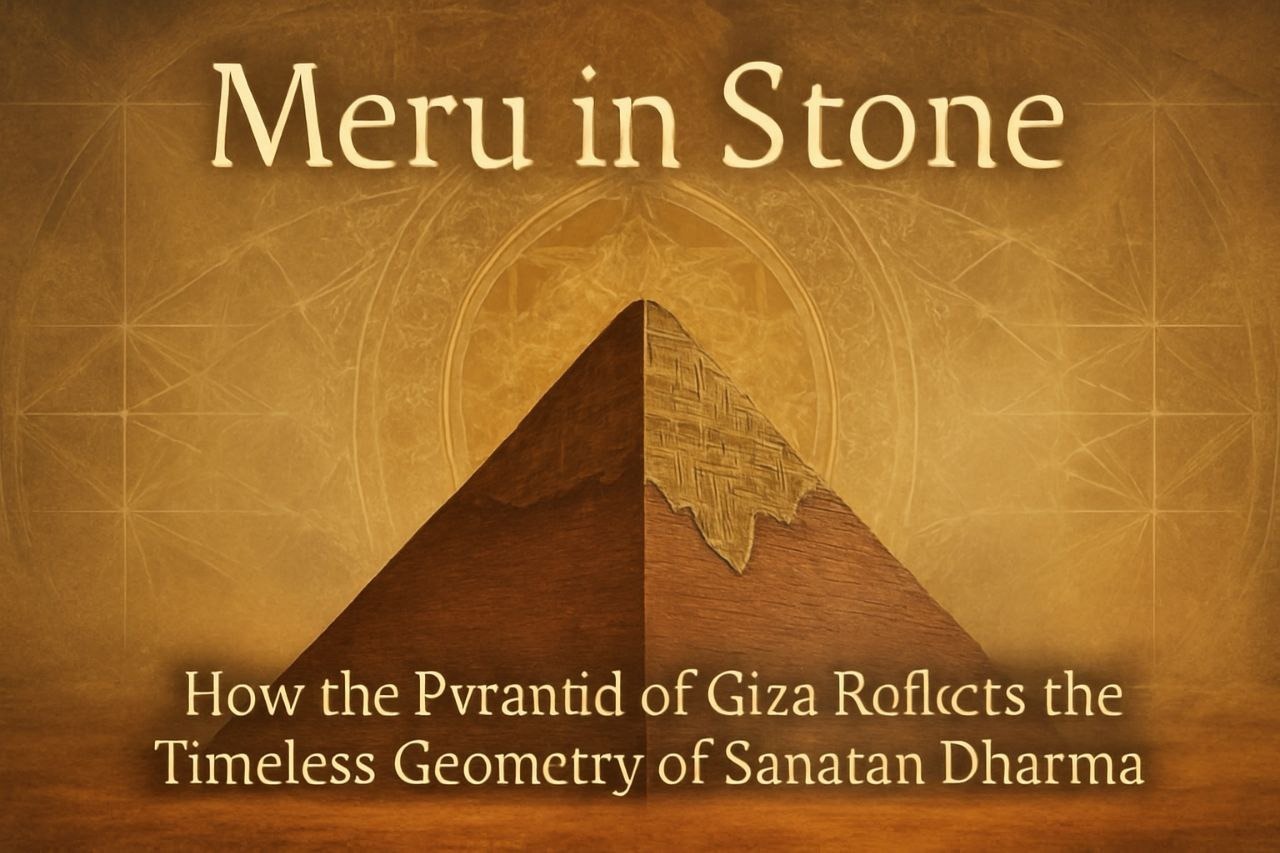Meru in Stone: How the Pyramid of Giza Reflects the Timeless Geometry of Sanatan Dharma

From the sands of Egypt rises a form so majestic, so timeless, that it has fascinated seekers, scientists, and mystics alike, the Great Pyramid of Giza. While historians frame it as a royal tomb, seekers of deeper knowledge sense something far more profound: that this monument echoes the eternal wisdom of Bharatvarsh, the land where Sanatan Dharma was born and nurtured.
In Sanatan thought, form is never merely form, it is vibration, alignment, and the visible manifestation of the invisible laws of the cosmos. The pyramid, though far from the banks of the Ganga, embodies principles that are described in Vastu Shastra, Shilpa Shastra, the Sulba Sutras, and the sacred archetype of Mount Meru.
“When you see with the eyes of the soul, the distance between Giza and Bharat disappears, only the eternal principles remain.” ~ Adarsh Singh
The Square Base: Foundation of Earth and Cosmic Order
In Vastu Shastra, the universe is represented through the Vastu Purusha Mandala, a perfect square, aligned to the cardinal directions, dividing space into zones of harmony. The Great Pyramid’s base is a perfect square aligned almost flawlessly to true north, echoing this cosmic alignment.
The four sides mirror the four directions, each guarded by the Dikpalas, the directional deities. Just as in Vedic temple architecture, this alignment is not mere aesthetics, it is a tuning of the structure to the pulse of the Earth and the cosmos.
The Rising Form: The Ascent of Meru
The pyramid’s gradual taper to a single apex mirrors the cosmic mountain Meru, the axis mundi described in the Puranas. Meru is not just a mythic peak, it is the spine of the universe, connecting Bhūloka (Earth realm) to Satyaloka (realm of truth and divinity).
Just as a temple shikhara rises toward the heavens, the pyramid channels energy from its broad earthly base toward the divine point at the top, symbolizing spiritual ascent.
The Sacred Ratios: Vedic Mathematics in Stone
The Sulba Sutras, ancient Vedic texts on geometry, describe precise ratios to transform the square into the circle, uniting the earthly and celestial realms. The Great Pyramid’s dimensions encode these same relationships:
Its perimeter relates to its height by a near-perfect 2π ratio.
Its height-to-half-base ratio approximates 4/π, a transformation principle seen in Vedic altar design.
These ratios are not random, they are the cosmic harmonies translated into architecture.
“Numbers are the language of the divine. The wise read them not in books, but in the stones, rivers, and stars.” ~ Adarsh Singh
The Inner Chamber: The Brahmasthāna of the Pyramid
In Vastu, the Brahmasthāna is the still center, the womb of power. It is where prana gathers, the spiritual heart of a structure. Inside the Great Pyramid, the so-called King’s Chamber is placed at a proportionally “sweet spot,” approximately one-third the way up, a placement that resonates with Vastu’s principle of the central energy point.
Here, energy is believed to stabilize, creating an environment conducive to preservation, clarity, and transformation, just as the garbhagṛha of a temple houses the deity and the deepest silence.
Sri Yantra and the 3D Maha Meru Connection
The Sri Yantra, with its interlocking triangles converging to a bindu, is the most sacred geometric symbol in Sanatan Dharma. When extruded into three dimensions, it becomes the Maha Meru, a stepped, tapering form uncannily reminiscent of a pyramid. Both are energy instruments: one in subtle sacred diagram form, the other in monumental stone.
This convergence suggests that the pyramid’s shape may not be an isolated Egyptian invention, but part of a shared ancient sacred science, what the rishis of Bharatvarsh perfected as the science of Vastu, Yantra, and Mantra.
Energy as the True Purpose
While modern historians often reduce the pyramid to a tomb, Sanatan wisdom teaches that such forms are built for energy resonance, for harmonizing cosmic forces, preserving life energy, and aiding consciousness to transcend limitations.
In Yogic terms, the pyramid is a massive yantra that channels energy along its Suṣumṇā, from the base to the apex, just as prana rises from the Mūlādhāra to the Sahasrāra in meditation.
A Bridge Between Lands and Ages
Whether or not ancient Egyptians directly drew from Bharat’s scriptures, the resonance is undeniable. Both civilizations revered the same universal truths: that form affects energy, that geometry can be sacred, and that architecture can be a bridge between the finite and the infinite.
“Civilizations may fade, stones may weather, but the laws of truth, harmony, and cosmic design remain unchanged through the ages.” ~ Adarsh Singh
The Living Lesson of Giza and Bharatvarsh
Standing before the Great Pyramid is not just an encounter with history, it is an encounter with eternal principles that Sanatan Dharma has always known:
⇛ That the Earth and cosmos are one continuum.
⇛ That human creations can be aligned to the rhythms of the universe.
⇛ That sacred geometry is a living science, not a lost art.
If we can reawaken this knowledge today, we too can build spaces, temples, homes, even cities, that nurture harmony, energy, and spiritual growth.
“The Pyramid of Giza is not merely Egypt’s wonder, it is a silent verse in the universal scripture of Sanatan Dharma.” ~ Adarsh Singh
Sun Aug 17, 2025
